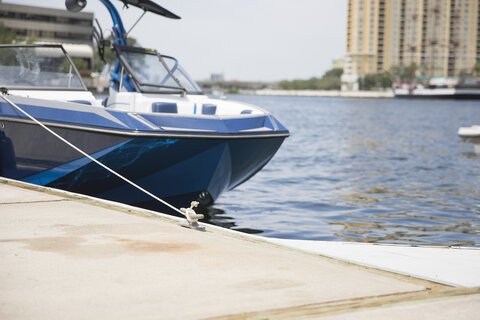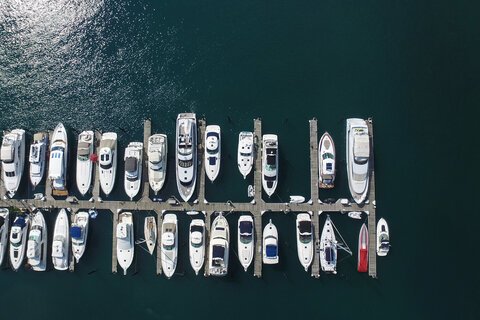Purchasing a boat from a private party is almost always a “buyer beware” situation, and if you are the buyer you want to make certain you are not purchasing a boat that’s going to come with a lot of problems, or is even unsafe. You can, and should, hire a professional marine surveyor to inspect a boat before you buy. A marine surveyor is like a house inspector for a boat, a pro with the tools, training and knowledge to spot problems with the structure and systems on a boat. A professional survey usually costs $20 to $25 per foot of boat length. Before you make this investment, you can do a quick survey of your own to spot some obvious issues that should cause you to look for another boat to buy.
New or Used Boats: How to Decide Which Type of Boat To Buy
Hull Identification Number
Every boat built since 1972 is required to have a 12-digit Hull Identification Number (HIN), which is analogous to the Vehicle Identification Number (VIN) on a car or truck. The HIN identifies the boat manufacturer, the model and serial number, and the date the boat was manufactured. The HIN is usually placed on the upper starboard transom of the boat. You can ask the seller for the HIN before you even visit the boat, and use the HIN to check to see if the boat has been reported stolen, was salvaged by an insurance company, and to make sure that the seller is really the owner of the boat and has a clear title. There are services that will run a background check on the HIN for a small fee. You can also simply do a Google search of the HIN and see what pops up. The United States Coast Guard also runs a Recall Database at uscgboating.org/content/recalls.php. If the boat is listed in this database you can call the boat manufacturer to find out if the recall was completed.
Scan the Hull
A good way to a start a boat inspection is by simply taking a good look at the hull. This is easier to do if the boat is on a lift or a sling, rather than a trailer. You are looking for any sign of repaired damage – an uneven surface or a wavy shape to the bottom or hull sides, a spot where the boat finish appears slightly mis-matched in color or texture, and any signs of bumps or blisters in the fiberglass. Pros will sometimes look at the boat with and without polarized sunglasses for a change in perspective. If you see something suspicious try to look at the same spot from inside the boat, and you may find evidence of a repair, which you should have inspected by a pro.
Soggy Transom
One of the most-common issues with fiberglass boats – and even some aluminum boats – is water infiltration in the transom. Most transoms have a core of wood or a composite material sandwiched between the thin inner and outer layers of fiberglass. Any place a hole is cut or drilled through the transom, for the outboard mounting bolts or the sterndrive, for a boarding ladder or transom U bolts, there is the potential for water to seep into this core and break it down. Each of these holes is supposed to be sealed and bedded to prevent this intrusion, but it’s not always done well. You can do a preliminary check of the transom by tapping the outer surface with the handle of a screwdriver or with a small hammer with a plastic head. Each tap should produce a solid ringing tone. If the tap produces a dull thud, and the tool bounces back, there could be water in the core. Start by checking around any place there’s a fitting in the transom, especially if it’s below or near the waterline. If you see a stain below a fitting, it could be a sign that water is actually leaking out of a soggy transom. A transom can be repaired or replaced, but this can be an expensive job. If left unrepaired the transom will weaken, to the point where the weight of an outboard could break it right off the boat.
Through-Hull Fittings
Insurance companies tell us that many boats sink at the dock, and a common culprit is a failed through-hull fitting that’s near the waterline. Plastic through-hull fittings can degrade and become brittle from UV exposure and eventually fail. These are easy to look at from outside the boat. Though-hull fittings should be bronze or another metal.
Hull-to-Deck Joint
Walk around the boat and give the hull-to-deck joint a close inspection. It should be smooth and even with no obvious gaps. Fresh sealant could indicate that a quick repair was made to a leaky joint. If you notice a mildew small in a boat cabin, it’s could be a sign that the hull-to- deck joint is leaking, or that a topside fitting, like a cleat or deck rail, is not properly bedded and water is getting into the hull lamination.
Electrical Issues
The battery should be secured in a covered box, or the positive terminal should be covered. A loose battery is a sign of a careless owner. Take a quick look under the helm for signs of amateur wiring, especially if accessories have been installed on the boat.
Engine Basics
Ask the seller for any receipts or other proof of regular engine maintenance or proper winterization. Pull the dipstick from a sterndrive engine or four-stroke outboard – if there’s milky oil on the dipstick it’s a sign of water in the oil. Observe the oil filter – if it looks old it may not have been changed in years.
While you have your head in the engine compartment, look at the inside of the hull for a scum line or water line that could indicate the boat was swamped at some point, which could mean the engine was underwater or the electrical system compromised. Do you smell gasoline? There could be a leak in the fuel system, or the fuel tank could be leaking, which is a big problem.
On a boat with stern drive power, push the drive left and right while the boat is out of the water. If it moves more than a quarter-inch, the gimbal bearings could be worn and need to be replaced.
A propeller that is badly dinged up or a damaged skeg in front of the prop is an indication that a previous owner was not a careful operator, and should make you wonder how well the rest of the boat was cared for.
Read Next: How to Buy a Pre-Owned Boat from a Private Seller


